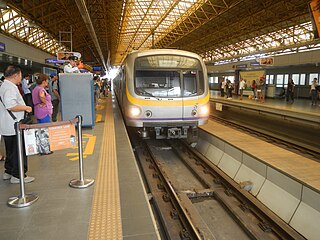
The Manila Light Rail Transit System, commonly known as the LRT, is an urban rail transit system that primarily serves Metro Manila, Philippines. Although categorized as a light rail system because it originally used light rail vehicles, it presently has characteristics of a rapid transit system, such as high passenger throughput, exclusive right-of-way, and later use of full metro rolling stock. The LRT is jointly-operated by the Light Rail Transit Authority (LRTA), a government corporation attached to the Department of Transportation (DOTr), and the Light Rail Manila Corporation (LRMC). Along with the Manila Metro Rail Transit System and the Metro Commuter Line of the Philippine National Railways, the system makes up Metro Manila's rail infrastructure.

The Metro Rail Transit Line 3, also known as the MRT Line 3, MRT-3 or Metrostar Express, is a light rapid transit system line of Metro Manila, Philippines. The line runs in an orbital north to south route following the alignment of the Epifanio de los Santos Avenue (EDSA). Although it has the characteristics of light rail, such as with the type of rolling stock used, it is more akin to a rapid transit system owing to its total grade separation and high passenger throughput.

Rail transportation in the Philippines is currently used mostly to transport passengers within Metro Manila and the nearby province of Laguna, as well as a commuter service in the Bicol Region. Freight transport services once operated in the country, but these services were halted. However, there are plans to restore old freight services and build new lines.

Recto station, also known as Recto Terminal Station, is the western terminus station of the Manila Light Rail Transit System Line 2, located on Recto Avenue at the district boundary of Santa Cruz and Quiapo in Manila. It is the first and last station for trains headed to and from Santolan. Its convenient location has helped create many businesses in the area, from the number of hotels and motels to restaurants and shops, with a good majority of them being a short walk from the station. It is also one of the busiest stations on LRT Line 2.

The Light Rail Transit Authority (LRTA) is a public transport operator that is responsible for the construction, operation, maintenance and/or lease of Manila Light Rail Transit System in the Philippines. Founded by Philippine President Ferdinand E. Marcos on July 12, 1980. It is organized as a government-owned and controlled corporation under the Department of Transportation (DOTr) as an attached agency.

Araneta Center–Cubao station, also called as Araneta–Cubao station or simply Cubao station, is a station on the Manila Light Rail Transit System Line 2. The station is located in Cubao in Quezon City and is named after the old name of Araneta City, a mixed-use development.

The Department of Transportation is the executive department of the Philippine government responsible for the maintenance and expansion of viable, efficient, and dependable transportation systems as effective instruments for national recovery and economic progress. It is responsible for the country's land, air, and sea communications infrastructure.

Katipunan station is a station on the Manila Light Rail Transit System Line 2. It is the only underground station in the entire line. The station is located in Loyola Heights in Quezon City and is named because of its location on Katipunan Avenue, one of Quezon City's main thoroughfares. The avenue is in turn named after the Katipunan revolutionary society.

The Light Rail Transit Line 1 commonly referred to as LRT Line 1 or LRT-1 is a light rapid transit system line in Metro Manila, Philippines, operated by Light Rail Manila Corporation (LRMC) and owned by the Light Rail Transit Authority (LRTA) as part of the Manila Light Rail Transit System. Currently, the line consists of 20 stations and runs on 19.65 kilometers (12.21 mi) of fully elevated route.

The Light Rail Transit Line 2, also known as LRT Line 2 (LRT-2), and previously MRT Line 2 (MRT-2) or Megatren, is a rapid transit line in Metro Manila in the Philippines, generally running in an east–west direction along the Radial Road 6 and a portion of the Circumferential Road 1.

Santolan station is a station on the Manila Light Rail Transit System Line 2. Santolan station is one of the many elevated stations that can be found on the line located in Barangay Calumpang in Marikina. The station is located on the stretch of the Marcos Highway and is named after the adjacent barangay Santolan in Pasig.

Anonas station is a station on the Manila Light Rail Transit System Line 2. Anonas station is one of the many elevated stations that can be found on the line. The station is located in Cubao in Quezon City and is named because of its location near Anonas Street.

The Metro Rail Transit Line 7, also known as MRT Line 7 or MRT-7, is a rapid transit line under construction in the Philippines. When completed, the line will be 22.8 kilometers (14.2 mi) long, with 14 stations. The line runs in a northeast–southwest direction, beginning at San Jose del Monte, Bulacan up to the North Triangle Common Station in North Avenue, Quezon City. The line will traverse Quezon City and Caloocan in Metro Manila and is envisioned to spur business and commerce at its inter-modal terminal station in San Jose del Monte, Bulacan. According to the latest update, the project is 54% complete as of January 2021. The project is expected to be finished by December 2022.

The transportation system in Metro Manila is currently inadequate to accommodate the mobility and other basic needs of a densely populated metropolis, the result of many factors and problems that the government has failed to provide or address. Metro Manila exists in a state of near-permanent gridlock, with people and goods trapped by the very system that is supposed to move them quickly and efficiently. Because of the insufficient public transportation network, car ownership has risen dramatically, contributing further to the congestion that occurs at all times of day on the road. Filipinos view cars as not just tools to get them to where they need to go; they also believe that their car is an important symbol of the success they have achieved in life. In recent years, however, the Philippine government has been pushing to improve the mass transit system through various infrastructure projects, hoping to solve the interlinked problems of transportation, land use and environment.

Emerald station is a station on the Manila Light Rail Transit System Line 2 in the Philippines. It is part of the Line 2 East Extension and one of many elevated stations that can be found on the line located in Barangay San Roque in Marikina. The station is located on the stretch of the Marcos Highway and is named after the adjacent Emerald Drive.
Pier 4 station is a proposed station of the Manila Light Rail Transit System Line 2 West Extension Project, which will extend the current line by up to 3.02-kilometre (1.88 mi). The extension line will begin at Recto station and will end at the Manila North Harbor in Tondo. The west extension project calls for the construction of three additional elevated stations, two on Recto Avenue and one on Mel Lopez Boulevard near Pier 4 of the Manila North Harbor. It was approved by the National Economic and Development Authority on May 19, 2015.
Tutuban station is a proposed station on the Manila Light Rail Transit System Line 2. It is part of the Line 2 West Extension project, a 3.02-kilometer (1.88 mi) extension from Recto station to the Manila North Harbor in Tondo. The west extension project calls for the construction of three additional elevated stations: two on Recto Avenue and one on Marcos Road near Pier 4 of the Manila North Harbor. It was approved by the National Economic and Development Authority on May 19, 2015.
The Light Rail Transit Line 6 is a proposed rapid transit system in Cavite. There have been two proposals for the line, with the first one shelved immediately in 2018. Another proposal emerged in 2017 and is currently under review by the National Economic and Development Authority (NEDA).

The Metro Manila Subway, formerly known as the Mega Manila Subway (MMS), is an under-construction underground rapid transit line in Metro Manila, Philippines. The 36-kilometer (22 mi) line, which will run north–south between Quezon City, Pasig, Makati, Taguig, and Pasay, consists of 15 stations between the Quirino Highway and FTI stations. It will become the country's second direct airport rail link after the North–South Commuter Railway, with a branch line to Ninoy Aquino International Airport.

The LRTA 1000 class is a class of high-floor light rail vehicles (LRV) currently operated by the Light Rail Manila Corporation. It first entered service under the Light Rail Transit Authority in 1984.


















